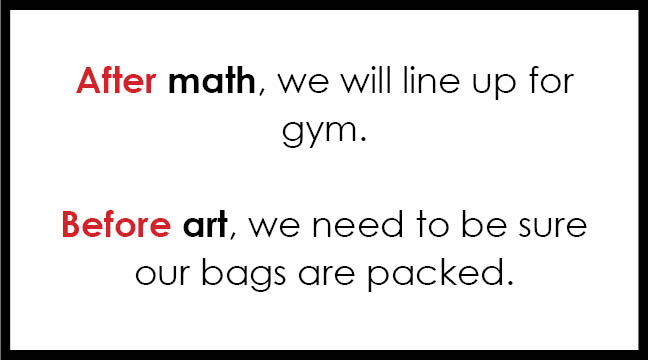How to Teach Prepositions: Time
Last week, we covered the definition, examples, and types of prepositions in our blog, How to Teach Prepositions: Location. We emphasized the importance and benefits of teaching prepositions in a multisensory manner: implementing body movement, color, images, and hands-on activities. Today we will explore prepositions of time.
Get ready to soar to new heights with this engaging lesson!
Types of Prepositions: Review
Location: under, over, in, by, between, upon, near, beneath, beside, inside, outside, below, etc.
- The word that follows the preposition is the central object as in the sentence, "The runners sprinted across the river."
Time: before, after, since, during, until, later, etc.
- These relate to a specific time such as in the sentence, "We will play before lunch." Lunch is the central event, and playing will happen in relation to that event in time.
Check out our previous blog, Parts of Speech Simplified, for more teaching ideas!

Teaching Prepositions of Time
What You Will Need:
- Crayons and/or markers
- Large, long sheets of paper like banner paper (one per group of children)
I. Choose an Event
I used lunch in my example sentence above, so let's go with that one for now. Lunch is the event and you will plan lunch to happen at noon.- Divide children into groups and give each group a long sheet of paper. Have the children make a "12" at the top center of the timeline. Then have them add a drawing under the twelve that shows the event: lunch. Next, have them add numbers before and after lunch to represent hours in the day.

II. Add Events
- Have the children discuss other events that happen in their day. Examples:

- Now, have the children divvy up the events and assign the ones they will use to members of their group. Each child should have an event to add to the timeline.
III. Choose Prepositions
- Next, the children will need to select a preposition as they decide when additional events happened in relation to lunch (i.e. before, during, after). In the sample sentences below, the preposition is red and the word the preposition refers to is bold. *Be sure to point out that the bold words are nouns.

III. Write & Illustrate
- Give each child a piece of paper and have them draw something to represent the event they were assigned, making sure to include their sentence as well.
- Now it's time for the group to collaborate on gluing the pictures where they should go on their timeline.
- Once all timelines are completed, give each group time to share with the class.

* In this example, you can't see any sentences, of course, but they would appear on each child's drawing.
IV. Follow-Up
The process of creating the timeline will make prepositions unforgettable. To follow up this learning activity, as you go through your day, reinforce prepositions of time by writing them on the board for the children to see. Example:

Notice the use of red prepositions and bold words that the preposition refers to. You don't have to follow that pattern, you could choose a different pattern that appeals to your class. Whichever pattern you choose to identify each, try to be consistent. Maintaining consistency will lead to retention and mastery for your students.
Conclusion
This engaging lesson will make the tricky concept of prepositions tangible and understandable, leading to effective learning success! Give it a try and experience the transformation from boring to soaring!
Please do not hesitate to contact us if you have any questions; we are here to help!





Leave a comment